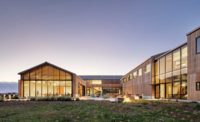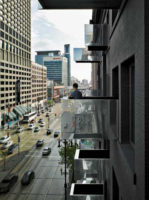In San Francisco, the comparatively chilly maritime climate often calls for wearing an extra layer, even in the summer. This goes for buildings too. For the recent renovation of a 78-year-old hybrid commercial and manufacturing facility in the city’s Design District, Pfau Long Architecture inserted an operable glass roof above a new warehouse atrium that can be that extra layer when the weather is cool or rainy but be opened on warm, sunny days. This light-filled, permeable space is a transformation of what had been a relatively utilitarian structure, and still honors its industrial nature.
Additional Content:
Jump to credits & specifications
The 100,850-square-foot concrete structure was built in 1939 for a chemical company. It comprised a two-story Art Deco office building facing the main thoroughfare, with a connecting one-story warehouse stretched out behind it. Both sections feature wood-framed roofs. The 1950’s addition of a narrow two-story wing along the length of its east side filled out an area once occupied by a rail spur line, so that the building occupied an entire city block.
For the last four decades, the building had been the headquarters and production center for the prom-gown designer Jessica McClintock. In 2014, a team of investors that included developer SKS Partners purchased the property to upgrade it for new business tenants, but not for the usual tech startups. The zoning in this area restricts occupancy to companies that fall under the broad umbrella of production, distribution, and repair (PDR)—a way for the city to support a diversity of businesses, from light manufacturing to design.
Though not on the city’s historic register, the Art Deco building remained true to its original form, though its interiors had been dramatically altered by intervening renovations over the years. The warehouse offered a raw canvas, so the architects took their design in two different directions. According to Pfau Long principal Dwight Long, “We were much more careful with the Art Deco facade, in terms of how we painted and lit the architectural features. With the rest, which was largely industrial, we took a more playful approach.”
Both firm and client agreed that the vast, dim warehouse, filled with a sea of columns, would be improved by carving out the center. “We’ve always felt that these big industrial buildings need to be opened up in the middle to bring natural light in,” says SKS managing partner Dan Kingsley, noting that the market values this type of intervention. In regard to function, “It’s also important for clients to have common spaces where people can meet and socialize,” says Long.
The original idea was to create an open-air courtyard. But the architects devised a solution that permits all-weather use of the 5,000-square-foot atrium: the installation of a greenhouse roof from the Netherlands that can be opened on warm days. This device turned out to be useful from a structural-engineering standpoint as well. “Developers don’t want open floor plates muddled up with shear walls and brace frames,” says Long. “Opening the center of the building let us do the necessary seismic work without interrupting the interiors.” Reinforced by steel channels surrounding the timber beams, the atrium is ringed by glass garage doors interspersed with shear walls clad in horizontal Douglas fir—actually repurposed roof sheathing from the building.
The architects connected the atrium to a side street, creating a second entrance that allows the building to accommodate multiple tenants gracefully—each with its own storefront opening to the daylit internal courtyard. For the current single tenant—a genetics-testing laboratory—the atrium serves as a café and lounge. Framed by cold-rolled steel, the new glazed entrance allows passersby to see into the courtyard. Above the doorway, a neon sign featuring the street number in the same font as the Art Deco entrance enlivens the long side street, as do the existing loading docks, also enclosed by glass garage doors.
To reinvigorate the Art Deco facade, the design team highlighted its details, which had been muted by uniform coloring, by painting them in shades of light gray. Then they replaced a concrete awning that wasn’t in the original building with one made of glass and steel.
On the inside of the Art Deco office building, they created a double-height lobby by switching out a closed 1990’s stair with an open one made of steel and concrete, revealing an existing skylight. The lobby is now flooded with daylight. Throughout this part of the building, dropped ceilings and drywall have made way for an exposed wood ceiling structure, concrete columns and beams, and board-formed concrete walls.
Even the chemical manufacturer’s old sign, painted on what had once been an exterior wall and discovered during construction, was left in place. As in the old warehouse and throughout the project, says Long, “We did our best to reveal and celebrate these details.”
CreditsArchitect: Pfau Long Architecture — Dwight Long, principal; Mallory Shure, Lauren Harrison, design team
Engineers: Murphy Burr Curry (structural); A.G.E. Consulting (m/e/p)
Consultants: Revolver Design (lighting); Public Design (environmental graphics)
General contractor: Charles Pankow Builders |
SpecificationsWindows Jerry Thompson & Sons (historic restoration)
Operable greenhouse roof Rough Brothers; BOAL Systems
Doors PRL Aluminum (metal); C.H.I. Overhead Door (garage)
Wood finishes and case goods Montbleau & Associates
Metal panels and furnishings Nor-Cal Metal Fabricators
Metal rails Romak Iron Works
Photovoltaic system SunPower; Sollega |













Post a comment to this article
Report Abusive Comment